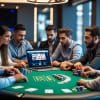
Only 15% of poker players make consistent profits from Multi-Table Tournaments (MTT).
The reality is stark. Thousands of players join MTT poker tournaments each day, but just a handful walk away with the most important winnings. Success requires more than just good poker skills – players need a specific MTT poker strategy that evolves through tournament stages.
Remember your last poker tournament? You might have played well at the start but hit a wall when blinds increased. Or maybe you bubbled out right before reaching the money. Every tournament player faces these challenges.
Our years of studying and implementing winning poker tournament strategies have taught us everything. We understand early stage fundamentals and complex ICM decisions deeply. This detailed guide will show you how to play tournament poker like a pro, whether you’re new to MTT poker or ready to level up your tournament game.
Want to join that winning 15%? Let’s take a closer look at the strategies you need to become skilled at MTT poker.
Understanding MTT Tournament Dynamics
Multi-Table Tournaments stand out as a unique format in the poker world. Players who want to develop a winning MTT poker strategy must grasp these simple dynamics.
Key Differences from Cash Games
Tournament poker shares simple poker principles with cash games, but players should know the vital differences. MTTs present unique challenges:
- Blind levels rise and push players to act
- Players cannot add more chips whenever they want
- Stack sizes change throughout the game
- Players must balance survival with chip gathering
Tournament Structures and Blind Levels
The tournament structure shapes your strategy substantially. A typical MTT blind structure looks like this:
| LevelSmall BlindBig BlindTypical Stack Impact | |||
| 1 | 25 | 50 | Deep stacks (100BB+) |
| 2 | 50 | 100 | Comfortable play |
| 3 | 75 | 150 | Strategy adjustment |
| 4 | 100 | 200 | Pressure builds |
Antes appear around level 3 or 4. They create bigger pots and push players to act more often. The optimal level duration runs about 20 minutes – enough time to play strategically yet maintain good tournament pace.
Prize Pool Distribution Impact
Prize pool distribution plays a vital role in decision-making. Most MTTs follow this pattern:
The top 15-20% of players get paid, and the final table receives about 30-40% of the total prize pool. This top-heavy structure requires players to balance survival with chip accumulation. Pay jumps grow larger at the final table, where the top three finishers typically split 30-40% of the prize pool.
This distribution pattern shapes your strategy. Players deep in a tournament must weigh their chip stack and the ICM implications of each move. Steeper payout structures demand more focus on building chips rather than mere survival.
Early Stage MTT Strategy
Early stages of MTT poker strategy give us the best chance to build a strong foundation for tournament success. Deep stacks and reasonable blind levels let us focus on playing solid, fundamental poker.
Starting Hand Selection
Successful early-stage play starts with proper hand selection. Players need stronger starting hands in early position, but can open up their range toward the button. Here’s a position-based approach that works well:
| PositionPremium HandsPlayable Hands | ||
| Early | AA-TT, AK-AQ | AJs+, KQs |
| Middle | 99-22, AJ+, KQ | AT+, KJ+, Suited Connectors |
| Late | 22+, Ax, KT+ | Any Two Connected Cards |
Stack Preservation vs Accumulation
Early stages require us to balance two competing goals:
- Stack Preservation: Deep stacks mean avoiding unnecessary risks
- Chip Accumulation: Building our stack when we spot clear edges
A cash game style approach works best until the antes kick in. This means you should:
- Stay away from marginal situations that risk your whole stack
- Bet for value aggressively with strong hands
- Take calculated risks only with significant equity advantages
Position Play Fundamentals
Position makes all the difference in early-stage MTT poker. Most chips flow to later positions, making them vital for stack building. A solid position-based strategy focuses on:
Early positions need tighter play to avoid tough post-flop spots. The button and cutoff let us widen our ranges by a lot. This becomes even more important once antes come into play.
Note that winning the tournament isn’t the goal in early stages. Building your stack step by step while staying flexible helps you adapt as the tournament structure changes.
Middle Stage Tactics
The real chess match starts as we move into the middle stage of our MTT poker strategy. Gone are the early stage’s comfortable stack depths. Now we face trickier waters where each decision weighs heavily on our success.
Bubble Play Dynamics
The bubble stage gives us our best chance to build chips, but players often make mistakes that get pricey. Different payouts create non-linear chip values that lead to the bubble effect. Here’s what you need to think about:
- Medium stacks face highest ICM pressure
- Short stacks must be more aggressive
- Big stacks can exploit others’ tight play
- Pay jumps change strategy in major ways
Stack Size Adjustments
Your stack depth compared to blinds and antes should shape your strategy. This approach works well:
| Stack SizePrimary StrategyKey Focus | ||
| >40BB | Pressure medium stacks | Exploit ICM pressure |
| 20-40BB | Selective aggression | High card holdings |
| 10-20BB | Push/fold territory | Premium hands |
Blind Stealing Strategy
Survival and chip growth in middle stages depend on blind stealing. Three factors determine stealing success:
- Table Image: Recent actions shape how others see you
- Opponent Tendencies: Tight players in blinds boost steal profits
- Stack Dynamics: Your stack size versus opponents matters
A 2.5x raise with antes gives you the best balance of risk and reward for stealing blinds. Note that with antes, steals only need to work half the time to make money.
Being the table aggressor makes stealing more effective. Consistent pressure on medium stacks near the bubble creates chances for profitable three-bets and light calls against your opens.
Stack sizes change the most during middle stages. You need to adjust your strategy often. Players with 15-25 big blinds trying to ladder up in pay jumps become your best targets because of their high bubble factors.
Advanced ICM Considerations
The ability to understand Independent Chip Model (ICM) sets successful tournament players apart from others. Players who become skilled at ICM calculations maximize their tournament equity and make better decisions.
Understanding Pay Jump Effect
Tournament payouts create unique dynamics in decision-making. MTT structures typically pay 15-20% of the field. The final three players receive 30-40% of the prize pool. This distribution creates substantial implications:
| PositionPrize Pool %Strategic Impact | ||
| 1st Place | 25-30% | Aggressive play needed |
| 2nd-3rd | 15-20% | Careful ICM consideration |
| Final Table | 40-50% | Maximum ICM pressure |
Risk-Reward Calculations
Chip value doesn’t scale linearly in tournaments – doubling our stack doesn’t double our equity. This creates a “risk premium” where players need higher equity to call all-in bets than in cash games. Stack sizes determine risk considerations:
- Big stacks (>40BB): Can apply pressure to medium stacks
- Medium stacks (20-40BB): Face highest ICM pressure
- Short stacks (<20BB): Have least ICM pressure to consider
ICM Pressure Points
Tournament experience reveals vital ICM pressure situations that need special attention. Field size shapes strategy – players stay tighter in smaller fields where laddering up matters more. Larger fields require aggressive chip accumulation.
ICM pressure peaks when:
- Players approach significant pay jumps
- Multiple short stacks exist
- Medium stacks face pressure from bigger stacks
ICM becomes a vital factor earlier than most players think – usually around 50% of the field remaining, well before the money bubble. This insight provides a significant edge in tournament play.
ICM decisions require analysis of both chip expected value (cEV) and monetary expected value ($EV). A profitable chip-EV situation might hurt tournament equity badly. Medium stacks at final tables face this reality often, where busting before a short stack would devastate overall tournament equity.
Note that: Tournament play values gaining chips less than the cost of losing the same amount. This basic ICM principle guides decisions throughout the later stages of MTTs.
MTT Final Table Strategies: Maximize Your Tournament Value
Making it to the final table in an MTT poker tournament is the peak of our strategic experience. After guiding through early stages, middle game complexities, and ICM considerations, we face our most vital decisions.
Deal Making and Negotiations
Understanding deal structures helps us maximize our tournament value. Two main methods shape final table negotiations:
| Deal TypeAdvantagesBest For | ||
| ICM Chop | Favors shorter stacks | When stacks are uneven |
| Chip Chop | Simple calculation | When stacks are similar |
These proven principles guide our deal negotiations:
- Start with a higher anchor point than our target
- Use cooperative language (“we” instead of “I”)
- Utilize our perceived skill edge in negotiations
- Think about our options if no deal happens
The best time to start deal talks usually comes when 3-4 players remain, though opportunities often arise as soon as the final table forms.
Short Stack Strategy
Our short stack approach at the final table needs precise adjustment. We’ve found that big blind values change based on stack size – a short stack values it near $300 while the chip leader sees just $65.
A short stack at the final table should focus on:
- First-in fold equity over calling all-ins
- Avoiding confrontations with larger stacks
- Targeting medium stacks who face maximum ICM pressure
- Staying aware of pay jump implications
Success comes from waiting for the right spots instead of forcing action. Players bring their best game to the final table, so patience becomes vital for short stack survival.
Heads-Up Adjustments
Our heads-up strategy needs big changes from earlier play. MTT players often struggle heads-up because they’re not used to the wide ranges needed to win.
In heads-up play, we:
- Open about 5% wider than against tough opponents
- Defend often from the big blind
- Mix premium hands with suited connectors
- Adjust our 3-betting range to 20%+ in good spots
Position advantage matters even more in heads-up play. On the button, we often open 100% of hands against opponents who fold too much.
The first 10 hands at the final table are key. We play tight and study our opponents. This observation time shows us their tendencies and emotional state. Most final table players either play their absolute best or crack under pressure.
Note that skill matters a lot, but luck plays its part at the final table. We focus on finding every edge by analyzing betting patterns and showdown hands.
Conclusion
Becoming skilled at MTT poker strategy requires deep understanding, constant adaptation, and disciplined execution during all tournament stages. Players need a detailed approach that covers everything from early-stage fundamentals to final table dynamics, which creates a roadmap to consistent tournament success.
Stack management, position play, and ICM considerations are the foundations of profitable tournament poker. Players must balance aggressive chip accumulation with strategic preservation and adapt their ranges based on tournament stage and stack depths.
Poor results often stem from players’ failure to adjust their strategy as tournaments progress. Tournament success depends on mastering each distinct phase – solid poker early on, exploitation of bubble dynamics mid-tournament, and navigation of complex ICM situations in later stages.
Note that tournament poker rewards patient aggression and calculated decision-making. Players who keep practicing these concepts, study their results, and refine their strategy will see improvement. A combination of proper bankroll management and dedication to improvement will help you join the elite 15% of profitable MTT players.













